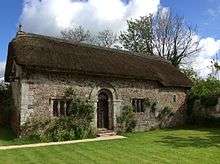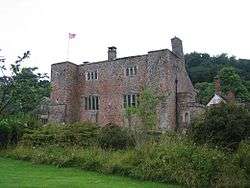Bickleigh Castle
| Bickleigh Castle | |
|---|---|
|
Bickleigh Castle, Gatehouse | |
| Location | Bickleigh in Devon, England |
| Coordinates | 50°51′05″N 3°30′45″W / 50.85139°N 3.51250°WCoordinates: 50°51′05″N 3°30′45″W / 50.85139°N 3.51250°W |
Listed Building – Grade I | |
| Official name: Bickleigh Castle Gatehouse | |
| Designated | 28 August 1987[1] |
| Reference no. | 1325638 |
Listed Building – Grade II* | |
| Official name: Bickleigh Castle chapel - including walls to enclosure to south and west | |
| Designated | 28 August 1987[2] |
| Reference no. | 1325639 |
Listed Building – Grade II* | |
| Official name: Old Court | |
| Designated | 24 October 1951[3] |
| Reference no. | 1106959 |
Listed Building – Grade II | |
| Official name: Bickleigh Castle, north range | |
| Designated | 28 August 1987[4] |
| Reference no. | 1170452 |
 Location of Bickleigh Castle in Devon | |
Bickleigh Castle is a fortified manor house that stands on the banks of the River Exe at Bickleigh in Devon, England. Once considerably larger, Bickleigh now comprises a group of buildings from various periods which together formed a water castle.
The main building was destroyed during the English Civil War, however other buildings, mostly arranged around a central courtyard survive, although frequently restored and revised survive. The castle has been open to the public and now serves as a wedding venue and provides holiday rentals.
History
A Norman motte castle of the late 11th or early 12th century was dismantled in the mid 12th century. During this time a small stone chapel was built in the bailey. In the 15th century the Courtney family built a mansion on the site and incorporated some of the earlier buildings. The Carew family then lived there for over two centuries.[1]
During the English Civil War Charles I's queen, Henrietta Maria stayed in the castle until word was received that Fairfax's Parliamentarian troops were approaching, following which she fled to France.[5] The bulk of the castellated structure was then demolished by Parliamentarian troops. The 'slighting' of Bickleigh was a response to the Royalist sympathies of the Carew family and its use as a stronghold during the conflict with the main manor house and inner keep being destroyed.[6]
Following the Restoration, a typical Devon farmhouse of cob and thatch was added.
The buildings subsequently fell into disrepair, and became a farm store and cottage until they were restored early in the 20th century. The Norman chapel and a 14th-century gatehouse still exist.
Buildings
The west range no longer survives. A building now known as the "Old Court" is south of the courtyard. Along with the North range and gatehouse most of the buildings were arranged around a central courtyard. The chapel is east of the rest of the buildings close to the River Exe. Moat Cottage is north of the other buildings.
Gatehouse
The gatehouse dates from the early 15th century and is a Grade I listed building. It is a three storey single-depth plan stone structure with an asbestos slate roof surmounted by turrets. A central carriage archway leads into a courtyard. The building was substantially restored in the 1920s and 1930s.[1]
Chapel

The present Norman chapel was built in the 11th century with the current "wagon roof" dating from the 15th century.[2] It is often cited as the oldest complete building in Devon.[7] It is believed that the chapel was built on the foundations of a Saxon building dating from the 6th century.[8] It was substantially renovated in the 20th century.[2]
Old Court
The Old Court was south of the range around the courtyard. It was built in the late 16th century, however it has been revised and added to many times and part of the structure may have been demolished. It may have formed a hall house covered by a five arch braced jointed truss cruck roof.[3]
North Range
The North Range was built in the late 17th century and served as a farmhouse. It is a two storey building with a thatched roof. In the left end room is a 17th-century overmantel carved with biblical scenes which may commemorate the role of the Carew family in putting down the Prayer Book Rebellion of 1549. The building was restored in the 1930s.[4]
Moat Cottage
Moat Cottage which stands to the north of the other buildings was constructed in the late 16th century. It is a stone building with a thatched roof.
Stable block
The thatched former stable block was rebuilt in the 19th century on the site of an earlier building. It is surmounted by a turret clock. It has now been converted into cottages and a visitor centre.[9]
Grounds
It is set in 30 acres (12 ha) of grounds of which 5 acres (2.0 ha) are landscaped.[10]
Current use
The castle was open to the public from 1970 to 1990 and was visited by 20,000 people each year.[11]
The castle and surrounding buildings are now available to rent as a wedding venue or as holiday lets.[12] The garden walls, gate piers and gates are also designated as listed buildings.[13]
References
- 1 2 3 "Bickleigh Castle Gatehouse". National Heritage List for England. Historic England. Retrieved 13 August 2016.
- 1 2 3 "Bickleigh Castle chapel - including walls to enclosure to south and west". National Heritage List for England. Historic England. Retrieved 13 August 2016.
- 1 2 "Old Court". National Heritage List for England. Historic England. Retrieved 13 August 2016.
- 1 2 "Bickleigh Castle, north range". National Heritage List for England. Historic England. Retrieved 13 August 2016.
- ↑ "Castle owners fear their dog could be put down after bruising a waiter's nose". Telegraph. 19 January 2016. Retrieved 13 August 2016.
- ↑ "Historical Timeline". Bickerleigh Castle. Retrieved 13 August 2016.
- ↑ "Bickleigh Castle". touruk.
- ↑ "Did you know". Bickleigh Castle. Retrieved 13 August 2016.
- ↑ "Former stable block in courtyard to - the north west of Bickleigh Castle". National Heritage List for England. Historic England. Retrieved 13 August 2016.
- ↑ "Bickleigh Castle". Garden Visit. Retrieved 13 August 2016.
- ↑ Norwood, Graham (12 May 2003). "How can a castle earn its keep?". Telegraph. Retrieved 13 August 2016.
- ↑ "Bickleigh Castle". Country Holiday House. Retrieved 13 August 2016.
- ↑ "Garden walls, gatepiers and gates to the east of Bickleigh Castle". National Heritage List for England. Historic England. Retrieved 13 August 2016.
Further reading
- Boxall, O. N. (1979). A Short History of Bickleigh Castle. Bickleigh. ASIN B002R6IHY6.
- Fry, Plantagenet Somerset, The David & Charles Book of Castles, David & Charles, 1980. ISBN 0-7153-7976-3
External links
| Wikimedia Commons has media related to Bickleigh Castle. |
